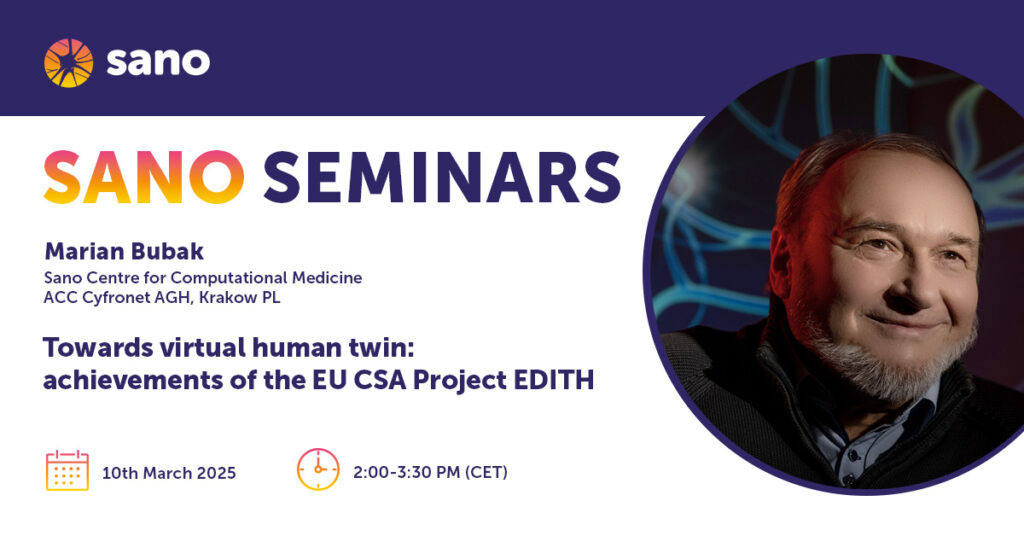154. Towards virtual human twin: achievements of the EU CSA Project EDITH
Marian Bubak Sano Centre for Computational Medicine and ACC Cyfronet AGH, Kraków, Poland
Computational medicine requires mathematical models of human physiology implemented as simulation modules, access to medical data, simulation procedures, software environment, computing infrastructures, and standardization and certification procedures [1, 2]. Research initiated by Peter Hunter [3] was continued under umbrella of Virtual Physiological Human [4] by many researchers and institutions like our Sano.
Recently, in the framework of the EU Project EDITH [5] coordinated by Liesbet Geris, a holistic and systematic approach was pursued aiming at determining principles and foundations for implementation of computational medicine: from cells and tissues to organs and entire body in the form of virtual human twin (VHT) [6]. To enable more efficient research and put the VPH idea into practice, we require an inclusive ecosystem, implementation of a federated repository gathering resources such as models, data sets, algorithms, practices, as well as a simulation platform on top of resources. The EDITH Roadmap [5] presents a set of recommendations related to creators and consumers in this area, basic building blocks of VHT technologies, infrastructures, ELSI, and sustainability conditions, standards and regulatory aspects.
The complexity and scale of VHT demand high-performance computing (HPC) to run computationally intensive simulations, training AI-based twins, and perform data-intensive analyses. The Cyfronet team has created a demonstrator for VHT simulations on HPC; it enables collaborative usage and reproducibility. The functionality of the demonstrator was successfully validated with a set of typical VHT modules and now it is further developed to become a central tool of a simulation system for strokes [7].
Acknowledgements
I’m very grateful to Marek Kasztelnik, Piotr Nowakowski, Piotr Połeć, Maciej Malawski and Jan Meizner for joint work. We thank grants EU: EDITH No 101083771 Digital Europe, GEMINI No 101136438 HORIZON, Teaming Sano No 857533, and Cyfronet AGH PLG/2023/016723.
References
- G. Tourassi: Computational medicine: Grand challenges and opportunities for revolutionizing personalized healthcare, Frontiers in Medical Engineering, vol. 1, 2023, 10.3389/fmede.2023.1112763
- P. Coveney, R. Highfield: Virtual You. How Building Your Digital Twin will Revolutionize Medicine and Change Your Life, Princeton University Press, 2023
- Physiom Project – https://www.auckland.ac.nz/en/abi/our-research/research-groups-themes/physiome-project.html
- VPH Institute – https://www.vph-institute.org/
- EDITH – European Virtual Digital Twin, EU Project, Digital Europe, https://www.edith-csa.eu/
- M. Viceconti, M. De Vos, S. Mellone, L Geris: Position paper from the digital twins in healthcare to the virtual human twin: a moon-shot project for digital health research, IEEE Journal of Biomedical and Health Informatics 28 (1), 491-501, 2024
- GEMINI – A Generation of Multi-scale Digital Twins of Ischaemic and Haemorrhagic Stroke Patients, EU Project, HORIZON, https://dth-gemini.eu/
Marian Bubak Sano Centre for Computational Medicine and ACC Cyfronet AGH, Kraków, Poland


